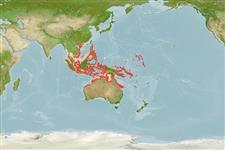Hexacorallia |
Scleractinia |
Oculinidae
Environment: milieu / climate zone / djupintervall / distribution range
Ekologi
Revassocierade; djupintervall 0 - 40 m (Ref. 847). Tropical; 22°N - 23°S, 95°E - 175°E (Ref. 847)
Indo-West Pacific.
Length at first maturity / Size / Weight / Age
Könsmognad: Lm ? range ? - ? cm
Colonies are composed of short irregular lobe-like or truncated branches and may reach several meters across. Corallites are tubular, thin walled with flaring rims. Pale brown or grey with white branch ends.
Usually found in reef areas with good water circulation and light availability (Ref. 847).
Life cycle and mating behavior
Könsmognad | Reproduktion | Lek | Eggs | Fecundity | Larvae
Members of the class Anthozoa are either gonochoric or hermaphroditic. Mature gametes are shed into the coelenteron and spawned through the mouth. Life cycle: The zygote develops into a planktonic planula larva. Metamorphosis begins with early morphogenesis of tentacles, septa and pharynx before larval settlement on the aboral end.
Veron, J.E.N. 2000 Corals of the world. Volume 2. Australian Institute of Marine Science and CRR Qld. Pty. Ltd. Australia. 429 p. (Ref. 847)
IUCN Red List Status
(Ref. 130435: Version 2025-1)
CITES status (Ref. 108899)
Not Evaluated
Threat to humans
Human uses
| FishSource |
Verktyg
Ytterligare information
Trophic EcologyFood items (preys)
Födosammansättning
Födointag
Predatorer
Population dynamicsTillväxt
Max. ages / sizes
Length-weight rel.
Length-length rel.
Length-frequencies
Mass conversion
Abundans
PhysiologySyreförbrukning
Human RelatedStamps, coins, misc.
Internet-källor
Estimates based on models
Preferred temperature
(Ref.
115969): 25.3 - 28.9, mean 27.8 (based on 366 cells).
Price category
Unknown.
